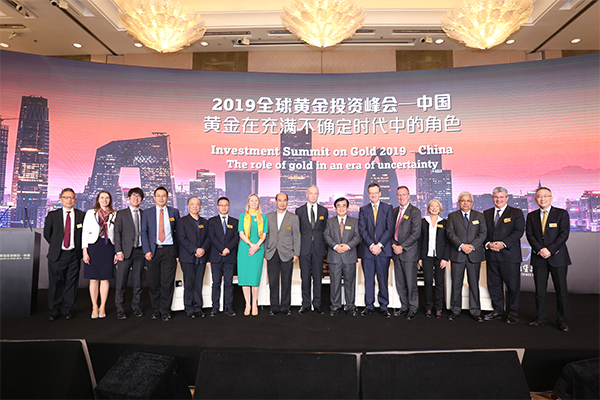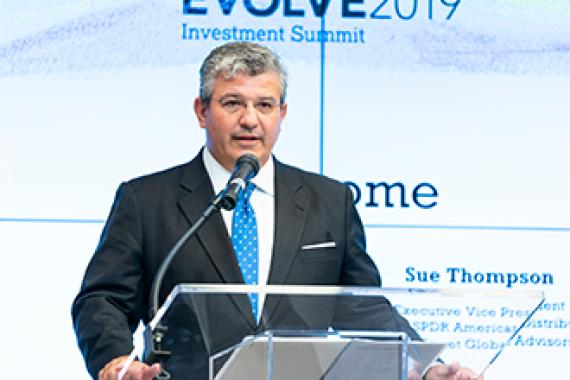Key programmes in 2019
2019 has been another fruitful year for our activities. From building relationships with central banks and institutional investors, through to large-scale research on retail investors, we have grown our relationships across the industry and advanced understanding of the case for gold.
QaurumSM – powered by the World Gold Council’s Gold Valuation Framework
QaurumSM is a web-based quantitative tool that helps investors intuitively understand the drivers of gold performance.
Developed in response to feedback from institutions that the lack of a framework is a key barrier to investment, QaurumSM enables investors to assess how different economic environments may impact gold returns over time. By using Qaurum,SM investors can calculate how various macroeconomic and geopolitical environments might impact the implied performance of gold over the next five years for as well as long-term 30-year returns. The scenarios available in QaurumSM are provided by Oxford Economics, an independent thinktank, considered a leader in global forecasting and quantitative analysis.
Accessible from Goldhub.com, QaurumSM involves three simple steps:
- Select a hypothetical macroeconomic scenario or customise your own
- Generate forecasts of demand and supply and view the impact of key macro driver
- Calculate and visualise implied returns for gold.
Underlying Qaurum’sSM user-friendly interface is the Gold Valuation Framework (GVF), robust and academically-validated methodology developed by the World Gold Council and based on the principle that the price of gold and its performance can be reliably explained by the interaction of demand and supply. This approach is distinguished from traditional valuation models such as cash flow analysis which are not directly applicable as gold does not pay a coupon or dividend.
By providing investors with a framework to evaluate gold’s performance with a quantitative rigour comparable to other asset classes, QaurumSM demystifies gold’s behaviour and can facilitate strategic and tactical allocation decisions.
Leading the dialogue on developments reshaping the investment management industry
On 12 September 2019, the World Gold Council held its EVOLVE Investment Summit in partnership with State Street Global Advisors at the historic Pratt House in New York City. Building on the World Gold Council’s inaugural summit in April 2018, EVOLVE aimed to further reinforce gold as a mainstream asset within the broader dialogue around developments reshaping the investment management industry. Branding the event EVOLVE aligned with its mission of driving ongoing dialogue around the constant regulatory, demographic, macro-economic shifts redefining the investor and asset manager agenda.
Attended by leading asset owners, asset managers and wealth managers, EVOLVE was a tremendous success convening multiple segments of the investment ecosystem to hear from preeminent thought leaders including:
- Lloyd Blankfein, former CEO and Chairman, Goldman Sachs
- Prof. Kenneth Rogoff, economist and Harvard public policy and economics professor
- Joyce Chang, Chair of Global Research, J.P. Morgan
- Frank Luntz, noted political commentator
- Cyrus Taraporevala, President and Chief Executive Officer, State Street Global Advisors
- Joe Zidle, Chief Investment Strategist, Blackstone.
In addition to covering relevant topics such as ESG, monetary policy, and global and emerging outlooks, EVOLVE served as the platform to introduce our Gold Valuation Framework and Responsible Gold Mining Principles. The event closed with a provocative presentation by top political commentator Frank Luntz on the US election landscape and potential implications for financial services.
Goldhub – the Chinese version
In order to offer our key content to a wider range of Chinese audiences we are collaborating with CFBOND (the leading financial media in China) to host a Chinese version of Goldhub on its platform. The content will focus on our research and blog content. We are working closely with CFBOND on the design and creation of this website, and plan to launch in H1 2020. CFBOND is the only integrated financial media to provide and manage financial data in China and is approved by the State Council and Central Publicity Department. Its readership runs to millions.
The largest ever consumer survey on gold
In 2019, we surveyed 18,000 consumers in what we believe to be the largest ever consumer survey focused on gold, covering the major markets of China, India, Germany and the US, as well as Canada and Russia.
The programme generated insights to help consumer facing gold retailers improve their sales and marketing strategies. Opportunities for growth within the retail investment market were identified: 38% of retail investors globally had never bought gold but would consider buying gold in the future if barriers around trust, awareness and understanding could be addressed.
These insights have already been used to influence the marketing strategies of some of the world’s leading mints. The programme is also supporting the development of the Retail Gold Investment Principles initiative. During 2020 we will publish a series of country-level reports based on our findings to support further in-depth industry engagement with the aim of helping the gold industry increase its retail presence and boost gold demand.
More information is available at www.retailinsights.gold

Gold-backed ETFs
2019 was an active year for both the gold-backed ETF category overall and the World Gold Council’s fund suite. As concerns around trade wars, Brexit, monetary policy and market volatility increased, investors embraced the safe haven and diversification benefits of gold. Total holdings in gold-backed ETFs reached all-time highs in September, exceeding periods when the gold price was substantially higher.
In November, GLD® celebrated its 15th anniversary with a ringing of the NYSE closing bell with distribution partner, State Street Global Advisors.
SPDR® Gold Trust (GLD®) and SPDR® Gold MiniSharesSM Trust (GLDMSM) also experienced significant milestones. In September 2019, GLDM surpassed the one billion dollar market, just over a year after being launched to meet the growing need for a gold investment product with lower management fees.
In November, GLD® celebrated its 15th anniversary with a ringing of the NYSE closing bell with distribution partner, State Street Global Advisors. Since its inception fifteen years ago GLD® has experienced many notable “firsts” including:
- first US traded gold ETF
- first commodity ETF
- first – and only! – to raise US$1bn in its first three days of trading.
A continual laser-focus on client demand and feedback is the foundation for the growth and evolution of the GLD® fund suite. In September 2019, the World Gold Council and State Street Global Advisors brought GLDMSM to Japan, while also making the decision to de-list SPDR® Long Dollar Gold Trust (GLDW).
Looking into 2020 and beyond, the World Gold Council is exploring opportunities to build on existing momentum by delivering the benefits of the GLD® suite to an even broader range of investors.

Central banking award win
The World Gold Council’s Central Banks and Public Policy team was honoured to receive the Central Banking Publication’s inaugural award for Professional Services Initiative of the year.
In 2018, we released the Guidance for Monetary Authorities on the recommended practice in accounting for monetary gold, which was well received by the central banking community. The award acknowledged our work in providing a common framework for the accounting of monetary gold in an appropriate and consistent manner – an important issue for many central banks.
Executive Programme in China
In October 2019 the World Gold Council convened the annual Executive Programme in Gold Reserves Management in Beijing, China, in partnership with the Tsinghua University PBC School of Finance. This programme had the highest attendance of any central bank training event ever organised by the World Gold Council, with more than 30 official institution attendees participating. The event also marked the first time an Executive Programme had been held in China, allowing participants to gain first-hand insight into the world’s second largest economy and the largest gold producer.
As central bank gold demand showed continued strength in 2019, the Executive Programme focused on the underlying factors driving official sector purchases – including geopolitical risk, negative interest rates and the need for diversification. Capitalising on the expertise of the PBC School of Finance, the event also delved into China’s economic outlook, the impact of renminbi internationalisation and the rapid proliferation of fintech in China. Participants departed with a stronger understanding not just of the gold market but also of China’s growing role in shaping it. Central banks continue to need deeper insights on gold and at the World Gold Council we remain committed to providing these by engaging with them through training, research and guidance.
Investment Summit on Gold – China and the second China Gold 50 event in Beijing
The Investment Summit on Gold – China was co-organised by the World Gold Council, PBC School of Finance and CGA, and supported by SGE and SHFE. This successful summit attracted a total of 23 international and local speakers, and 125 delegates (30% institutional investors and 70% from the gold trade). The event provided an excellent platform for debate and in-depth analysis into the case for gold.
The second China Gold 50 dinner, organised by the World Gold Council, followed the Summit and was attended by almost 60 industry leaders. China Gold 50 is to become a regular dialogue platform that will allow industry leaders to contribute towards the debate for sustainable development within China’s gold market.
In addition, we worked with the CGA to conduct the very first World Gold Council China Chapter meeting. The event was attended by the World Gold Council’s Chinese Members as well as three Chinese gold miners who sought a better understanding of the Chapter’s aims. The delegates unanimously recognised the value of the China Chapter and were eager to support the high-level recommendations initiated by it for the further internationalisation and global cooperation of China’s gold mining industry.

India aims to bring greater transparency to gold as a mainstream asset class
The dynamics of India’s gold industry, with its thousands of small jewellers and millions of skilled artisans, predicate a bottom-up approach to reforms. These are not necessarily quick but are, nevertheless, sustainable. Following the parliamentary announcement in February 2018 by India’s then Finance Minister that the Government of India would create policies to establish gold as an asset class, India’s policy actions are beginning to generate trust and transparency in the gold market.
On 29 November 2019 the Minister of Consumer Affairs announced that mandatory hallmarking would be introduced in India from 15 January 2020.
Under-caratage and, as a consequence, mistrust in the industry, have been at the core of gold policy issues. On 29 November 2019 the Minister of Consumer Affairs announced that mandatory hallmarking would be introduced in India from 15 January 2020. Trade is to be given a year to transition with their existing inventory. India had earlier informed World Trade Association members about this regulation as a matter of trade protocol.
 Hallmarking was first introduced in India in early 2000 with the support of the World Gold Council, but this was voluntary and consumer awareness remained low. A law to make this mandatory was introduced in 2017 together with draft regulations. We have supported this development with two studies in the last few years: Developing Indian hallmarking and Mandatory hallmarking – global practices and roadmap for India. The assay training institute, launched in 2018 in collaboration with MMTCPAMP and with the support of key industry associations, will play a pivotal role in promoting the eco-system for mandatory hallmarking. Introduction of mandatory hallmarking will create significant economic benefits by enhancing employment opportunities in assaying and purity verification and by enabling jewellers to leverage Prime Minister Modi’s “Make in India” initiative in our aspiration to be seen as “Jeweller to the world.”
Hallmarking was first introduced in India in early 2000 with the support of the World Gold Council, but this was voluntary and consumer awareness remained low. A law to make this mandatory was introduced in 2017 together with draft regulations. We have supported this development with two studies in the last few years: Developing Indian hallmarking and Mandatory hallmarking – global practices and roadmap for India. The assay training institute, launched in 2018 in collaboration with MMTCPAMP and with the support of key industry associations, will play a pivotal role in promoting the eco-system for mandatory hallmarking. Introduction of mandatory hallmarking will create significant economic benefits by enhancing employment opportunities in assaying and purity verification and by enabling jewellers to leverage Prime Minister Modi’s “Make in India” initiative in our aspiration to be seen as “Jeweller to the world.”
The Blueprint for a gold spot exchange in India, a report we prepared with the support of 27 leading industry members including global bullion banks, has altered the course of debate from “if” to “when.” A series of industry meetings on logistics and good delivery, and trade visits to markets such as China, UK and Turkey, have taken place as the industry awaits the announcement of the implementation roadmap. This has been followed up by a syndicate of leading exchanges and legal practice working on a legal framework along with membership norms for formation of a central gold body.
Using industry insights, we have published a study report, The need for bullion banking in India, which will help steer policy dialogue and actions around this requirement throughout 2020/21.
Bullion banking in India is small and non-core, limited by regulations and a lack of infrastructure. We want to ensure that this large market is well supported and India is able to tap its market potential of US$300-500 million. To aid this objective, we will launch a full suite of product offerings to trade and consumers over the next few years. This will also meet the government objective to make gold an asset class whilst balancing macro-economic concerns. Using industry insights, we have published a study, The need for bullion banking in India, which will help steer policy dialogue and actions around this requirement throughout 2020/21.
The first meeting to secure industry support for the development of the retail gold investment sector was held in Delhi in November 2019. It was a huge success with over 20 industry leaders wholeheartedly agreeing to drive this initiative and proposing additional committee memberships for appropriate regional and sectoral representation. We anticipate that this initiative will bring the industry under a single umbrella and create a unifying voice, making the process of reform considerably smoother for the government.
Fintech initiative in India shows promising future for digital investment platform
Accessibility is a key driver of gold demand. Access may be perceived as difficult because of limited retail distribution points, while stiff prices impede accumulation of minimum deliverable quantities. This is particularly true in India where demand in rural areas is likely to be driven from the bottom of the pyramid as millions become savers for the first time following economic growth and rising prosperity.
As part of our Fintech strategy we helped develop a digital gold platform, SafeGold, to give easy access to both small and micro savers, addressing issues of purity, price transparency, safety and security for tech-savvy millennials higher up the economic value chain.
SafeGold has proved a successful model with a robust technology platform, having crossed milestones set out at inception in terms of customers, transaction volumes and distribution partnerships. SafeGold promotes good governance by strict adherence to our Internet Investment Gold (IIG) Providers’ Guidance. We see the digital gold market in India as an opportunity for 15 to 20 tonnes growth over the next three to five years. Going forward, we plan to collaborate with SafeGold as a springboard to expand in southeast Asian and Middle Eastern markets.
The Responsible Gold Mining Principles
Launched in September, the Responsible Gold Mining Principles (RGMPs) are a framework that set out clear expectations for consumers, investors and the downstream gold supply chain as to what constitutes responsible gold mining. Working with our members and collaborating with key industry stakeholders, we set out the Principles that we believe address key environmental, social and governance issues for the gold mining sector. It is our aim that these Principles will become a credible and widely recognised framework through which gold mining companies can provide confidence that their gold has been produced responsibly. The Responsible Gold Mining Principles are intended to recognise and consolidate existing standards and instruments under a single framework.




 Hallmarking was first introduced in India in early 2000 with the support of the World Gold Council, but this was voluntary and consumer awareness remained low. A law to make this mandatory was introduced in 2017 together with draft regulations. We have supported this development with two studies in the last few years:
Hallmarking was first introduced in India in early 2000 with the support of the World Gold Council, but this was voluntary and consumer awareness remained low. A law to make this mandatory was introduced in 2017 together with draft regulations. We have supported this development with two studies in the last few years: 